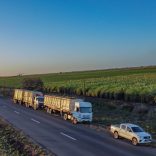Mozambique: Missaua water poisoned with Deltamethrin
Mozambique: Deforestation worries experts

File photo: DW
Mozambique is losing forest at the equivalent of over 300 football fields every day. The Rural Observatory (OMR) suggests modernising agriculture to halt the pace of deforestation.
caption – Deforestation continues at a rapid pace in Mozambique, twenty years after the adoption of the Land Law
“We have had some positive results, but we have not been able to reduce deforestation rates in the country,” João Carrilho, a researcher at Mozambican non-governmental organisation Rural Environment Observatory (OMR), says.
Around 41% of Mozambique is forested, equivalent to 34 million hectares, of which the country loses about 86,000 hectares (more than 120,000 football fields) annually through deforestation.
Losses since the 1970s total more than eight million hectares, an area nearly the size of Portugal, according to recent figures released by the Mozambican government in partnership with the World Bank.
It’s agriculture’s fault
Most deforestation and forest degradation in the country is caused by unsustainable agricultural practices which undermine social, environmental and economic well-being, the OMR says.
“There is a misconception that the main reason for deforestation is the cutting of wood for firewood and coal. But that’s not true. Sixty-five percent of the area deforested annually is used for agriculture,” Carrilho explains.
Two of the main impacts of deforestation are increased greenhouse gas emissions, albeit to a small extent in the case of Mozambique, and landslides, as forests are important for soil retention.
Improve agricultural practices
Mozambican academic Almeida Sitoe says that the money made in forest conversion process should be invested in the development of agriculture, in the energy sector and in the “education of the very people who depend on the forest.”
Forest clearing for another purpose, often agriculture, is often erroneously associated with “development”, Sitoe points out.
In Mozambique, agriculture is practised by over 80% of families living in rural areas, and is the main source of food and income. Nevertheless, the country has one of the lowest levels of agricultural productivity in southern Africa.
Carrilho therefore advocates improving agricultural technology, so that more can be produced in the same area.
“And if we do not start today, by 2050 we will have twice the population, double the need for food and the forests shrinking,” he warns.
Carrilho also urges the conversion of Mozambique’s current forestry legislation into an instrument focused on the management of forest resources rather than on their exploitation.
From Sitoe’s point of view, forestry resource management involves the integration of different sectors, so that “logging is no longer viable, and people will look at the forest and say that it is not worth cutting it down, because they will not earn more compared to other ways of using it.”













Leave a Reply
Be the First to Comment!
You must be logged in to post a comment.
You must be logged in to post a comment.